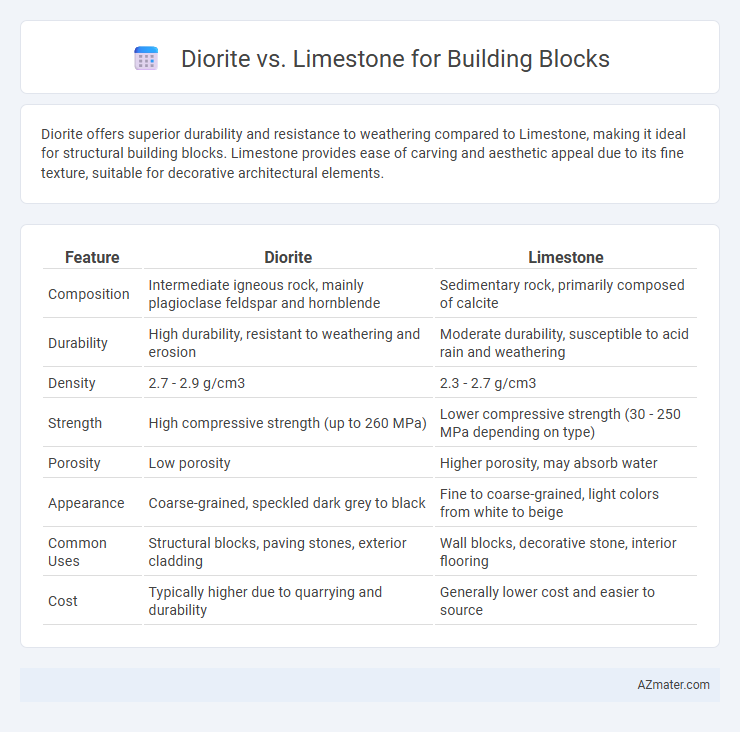Diorite offers superior durability and resistance to weathering compared to Limestone, making it ideal for structural building blocks. Limestone provides ease of carving and aesthetic appeal due to its fine texture, suitable for decorative architectural elements.
Table of Comparison
| Feature | Diorite | Limestone |
|---|---|---|
| Composition | Intermediate igneous rock, mainly plagioclase feldspar and hornblende | Sedimentary rock, primarily composed of calcite |
| Durability | High durability, resistant to weathering and erosion | Moderate durability, susceptible to acid rain and weathering |
| Density | 2.7 - 2.9 g/cm3 | 2.3 - 2.7 g/cm3 |
| Strength | High compressive strength (up to 260 MPa) | Lower compressive strength (30 - 250 MPa depending on type) |
| Porosity | Low porosity | Higher porosity, may absorb water |
| Appearance | Coarse-grained, speckled dark grey to black | Fine to coarse-grained, light colors from white to beige |
| Common Uses | Structural blocks, paving stones, exterior cladding | Wall blocks, decorative stone, interior flooring |
| Cost | Typically higher due to quarrying and durability | Generally lower cost and easier to source |
Introduction to Diorite and Limestone
Diorite is a coarse-grained igneous rock composed primarily of plagioclase feldspar and hornblende, valued for its durability and aesthetic appeal in construction. Limestone, a sedimentary rock mainly consisting of calcium carbonate, is widely used in building blocks due to its workability and natural resistance to weathering. Both materials offer unique structural and visual properties, influencing their selection for architectural and engineering applications.
Geological Formation of Diorite and Limestone
Diorite forms deep within the Earth's crust through the slow cooling and solidification of intermediate magma, resulting in a coarse-grained, intrusive igneous rock composed mainly of plagioclase feldspar and amphibole. Limestone originates from the accumulation of marine organism shells and calcium carbonate sediments, undergoing compaction and cementation in shallow, warm marine environments, producing a sedimentary rock rich in calcite. These distinct geological formations influence their durability and suitability for building blocks, with diorite exhibiting high strength and resistance, while limestone offers ease of shaping but lower hardness.
Physical Properties Comparison
Diorite exhibits higher hardness and greater durability compared to limestone, making it more resistant to weathering and wear in construction applications. Limestone has a lower density and is more porous, which can lead to increased water absorption and reduced resistance to freeze-thaw cycles. The compressive strength of diorite typically surpasses that of limestone, providing enhanced structural support for building blocks.
Durability and Weather Resistance
Diorite exhibits exceptional durability and superior weather resistance due to its dense crystalline structure, making it highly suitable for exterior building blocks subjected to harsh climates. Limestone, while versatile and easier to quarry, is more porous and prone to erosion and acid rain damage, limiting its long-term performance in weather-exposed applications. Choosing diorite ensures greater longevity and structural integrity in environments with significant moisture and temperature fluctuations.
Aesthetic Appeal and Texture Differences
Diorite features a coarse-grained texture with a speckled pattern of white, black, and grey minerals, offering a striking, natural-looking aesthetic ideal for elegant architectural designs. Limestone exhibits a finer grain and more uniform coloration, ranging from creamy white to beige, providing a smooth and classic appearance favored in traditional and refined building facades. The textured roughness of diorite creates a bold visual impact, while limestone's subtle, consistent surface enhances light reflection and a softer architectural feel.
Workability and Construction Ease
Diorite offers superior durability but is harder to work with due to its dense, coarse-grained texture, requiring specialized tools for cutting and shaping. Limestone features excellent workability with a softer composition, enabling easier cutting, carving, and installation, which reduces labor time and costs during construction. The choice between diorite and limestone depends on balancing the need for strength against ease of handling and finishing on-site.
Environmental Impact and Sustainability
Diorite exhibits greater durability and lower porosity compared to limestone, resulting in enhanced longevity and reduced maintenance for building blocks, which translates to less frequent replacement and lower environmental impact over time. Limestone extraction often involves more intensive quarrying processes that can lead to significant habitat disruption and higher carbon emissions, whereas diorite's harder composition typically requires less frequent extraction cycles. Choosing diorite contributes to sustainability by minimizing resource depletion and promoting longer-lasting construction materials with lower lifecycle environmental costs.
Cost Analysis: Diorite vs Limestone
Diorite typically commands a higher price than limestone due to its greater hardness, durability, and the complexity involved in quarrying and processing. Limestone, being more abundant and easier to cut, offers a more cost-effective option for large-scale construction projects with moderate strength requirements. When considering long-term value, diorite's resistance to weathering and wear may justify its initial higher cost in structures demanding enhanced longevity and low maintenance.
Common Architectural Uses
Diorite is preferred for building blocks in high-strength structural applications due to its durability and coarse-grained texture, making it suitable for load-bearing walls, foundations, and decorative facades. Limestone is widely used in architectural elements like cladding, flooring, and ornamental features because of its ease of carving, availability in various colors, and weather-resistant properties. Both materials are common in historic monuments and modern construction, with diorite valued for strength and limestone for aesthetic versatility.
Choosing the Right Stone for Your Project
Diorite offers exceptional durability and resistance to weathering, making it ideal for high-traffic or exterior building blocks where strength is crucial. Limestone provides ease of carving and a uniform texture, suitable for decorative facades and interior applications requiring aesthetic appeal. Selecting the right stone depends on project requirements: prioritize diorite for structural resilience and limestone for intricate design and warmer color tones.

Infographic: Diorite vs Limestone for Building Block
 azmater.com
azmater.com